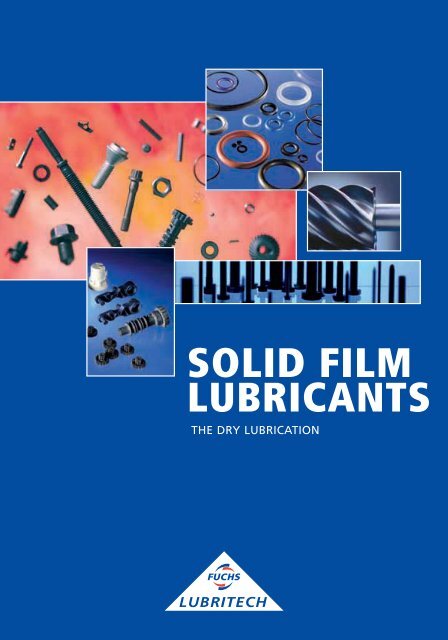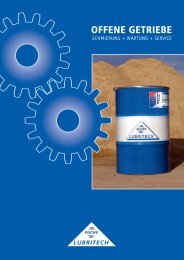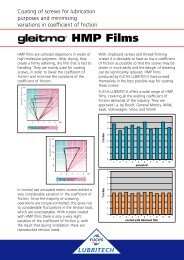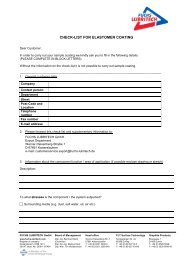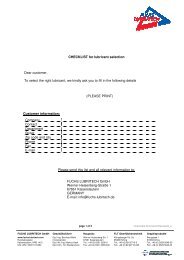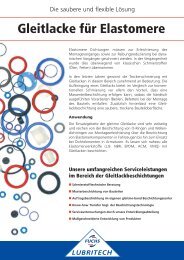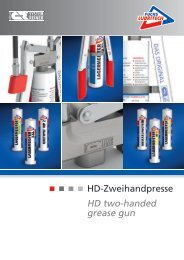SOLID FILM LUBRICANTS - FUCHS LUBRITECH GmbH
SOLID FILM LUBRICANTS - FUCHS LUBRITECH GmbH
SOLID FILM LUBRICANTS - FUCHS LUBRITECH GmbH
You also want an ePaper? Increase the reach of your titles
YUMPU automatically turns print PDFs into web optimized ePapers that Google loves.
<strong>SOLID</strong> <strong>FILM</strong><br />
<strong>LUBRICANTS</strong><br />
THE DRY LUBRICATION
.........................................................................................................................................<br />
.........................................................................................................................................<br />
CONTENTS<br />
INTRODUCTION...................................................................................................................... 3<br />
STRUCTURE AND FUNCTION OF <strong>SOLID</strong> <strong>FILM</strong> <strong>LUBRICANTS</strong>...................................................... 4<br />
PERFORMANCE RANGE OF <strong>SOLID</strong> <strong>FILM</strong> <strong>LUBRICANTS</strong>.............................................................. 6<br />
PRE-TREATMENT AND APPLICATION....................................................................................... 7<br />
TYPICAL TEST METHODS FOR <strong>SOLID</strong> <strong>FILM</strong> <strong>LUBRICANTS</strong>.........................................................10<br />
SELECTION AND USE OF <strong>SOLID</strong> <strong>FILM</strong> <strong>LUBRICANTS</strong>.................................................................12<br />
USING <strong>SOLID</strong> <strong>FILM</strong> <strong>LUBRICANTS</strong> ON VARIOUS AUTOMOTIVE APPLICATIONS......................... 13<br />
<strong>FUCHS</strong> <strong>LUBRITECH</strong>'S <strong>SOLID</strong> <strong>FILM</strong> LUBRICANT CONCEPT.........................................................14<br />
APPENDIX<br />
APPLICATIONS.......................................................................................................................16<br />
CHARACTERISTIC DATA........................................................................................................ 17<br />
CHECK-LIST – <strong>SOLID</strong> <strong>FILM</strong> LUBRICANT COATING...................................................................18<br />
2 <strong>SOLID</strong> <strong>FILM</strong> <strong>LUBRICANTS</strong> - THE DRY LUBRICATION<br />
<strong>FUCHS</strong> <strong>LUBRITECH</strong> GMBH
................................................................................................................<br />
................................................................................................................<br />
NTRODUCTION<br />
INTRODUCTION<br />
In many instances, if it's a question of dry film<br />
lubrication, solid film lubricants are the optimum<br />
choice. Solid lubricant coating has proved its<br />
worth many times over and today provides a reliable<br />
and indispensable design element.<br />
Increases in automated production and assembly makes<br />
solid film lubricants ever more important. They make it<br />
possible to provide many structural components with<br />
dry, efficient lubrication and, compared with conventional<br />
lubricants, permit designs to be simpler. They<br />
improve the running-in of highly-stressed machinery<br />
components, simplify installation processes and,<br />
in many instances, guarantee maintenance-free<br />
lifetime lubrication.<br />
Solid film lubricants manufactured by <strong>FUCHS</strong> <strong>LUBRITECH</strong><br />
are "state-of-the-art" and meet the increasing technical<br />
demands made by diverse sectors such as industrial and<br />
plant technology, metal-processing industry, machinery<br />
construction and the commodity goods and automotive<br />
industries.<br />
In addition to their outstanding technical properties, the<br />
solid film lubricants made by <strong>FUCHS</strong> <strong>LUBRITECH</strong> also<br />
comply with the ever-increasing demands to address<br />
environmental issues.<br />
<strong>FUCHS</strong> <strong>LUBRITECH</strong> GMBH<br />
INTRODUCTION<br />
<strong>SOLID</strong> <strong>FILM</strong> <strong>LUBRICANTS</strong> - THE DRY LUBRICATION 3<br />
........<br />
........
........<br />
........<br />
STRUCTURE AND FUNCTION OF <strong>SOLID</strong> <strong>FILM</strong> <strong>LUBRICANTS</strong> .......................................................................<br />
.......................................................................<br />
TRUCTURE<br />
STRUCTURE AND FUNCTION<br />
AND OF <strong>SOLID</strong> FUNCTION<br />
<strong>FILM</strong> <strong>LUBRICANTS</strong><br />
Solid film lubricants are carefully selected solid lubricants combined<br />
with organic or inorganic binders dispersed in solvents.<br />
The fundamental difference compared with normal industrial varnishes<br />
is that they contain solid lubricants instead of colour pigments.<br />
Apart from the main components – binders, solid lubricants and<br />
solvents – solid film lubricants may also contain functional additives<br />
such as corrosion inhibitors or UV active components.<br />
COMPOSITION OF <strong>SOLID</strong> <strong>FILM</strong> <strong>LUBRICANTS</strong><br />
Solid Lubricants<br />
MoS 2, graphite, PTFE ...<br />
Binders<br />
Epoxy-, polyurethane-, amide-imide-, silicone resin …<br />
Solvents<br />
Organic solvents, water<br />
Additives<br />
Corrosion protection, wetting, preservatives, UV additive ...<br />
4 <strong>SOLID</strong> <strong>FILM</strong> <strong>LUBRICANTS</strong> - THE DRY LUBRICATION <strong>FUCHS</strong> <strong>LUBRITECH</strong> GMBH
.......................................................................<br />
.......................................................................<br />
30 μm<br />
10 μm<br />
10-15 μm<br />
Coefficient of Friction μ<br />
INDUSTRIAL VARNISH<br />
<strong>SOLID</strong> <strong>FILM</strong> LUBRICANT<br />
<strong>SOLID</strong> <strong>FILM</strong> LUBRICANT<br />
ON PHOSPHATED METAL<br />
STRIBECK DIAGRAM: MODEL OF THE FRICTION AREAS<br />
DURING FLUID LUBRICATION<br />
<strong>FUCHS</strong> <strong>LUBRITECH</strong> GMBH<br />
Binder Colour pigment<br />
Metal<br />
Solid lubricant<br />
deposited on<br />
surface<br />
Solid lubricant<br />
FUNCTION OF A <strong>SOLID</strong> <strong>FILM</strong> LUBRICANT<br />
Opposing surface<br />
1) Partial separation of<br />
the solid lubricant<br />
from the coating<br />
Boundary friction<br />
Static friction<br />
Mixed friction<br />
Hydrodynamic friction<br />
(Fluid lubrication)<br />
Solid lubricant impregnated<br />
into surface<br />
Phosphate layer<br />
Opposing surface Opposing surface<br />
2) Transfer of the solid<br />
lubricant onto the<br />
opposing surface<br />
Rotational speed n<br />
3) Formation of the<br />
transfer film<br />
Boundary friction<br />
Mixed friction<br />
Hydrodynamic<br />
friction<br />
Solid film lubricant<br />
Oil<br />
STRUCTURE AND FUNCTION OF <strong>SOLID</strong> <strong>FILM</strong> <strong>LUBRICANTS</strong><br />
After drying and curing, solid film lubricants form a<br />
strong dry coating several microns thick, by adhering<br />
firmly to the substrate. The film reduces both<br />
wear and friction as well as acting as a parting<br />
agent and provides lubrication between the opposing<br />
surfaces.<br />
10μm<br />
Scanning electron micrograph of the surface of a MoS 2 solid film lubricant layer<br />
before applying frictional load.<br />
10μm<br />
Scanning electron micrograph of the surface of a MoS 2 solid film lubricant layer<br />
after frictional loading – smoothing of the surface of the solid film lubricant.<br />
Initial smoothing of the surface of the solid film<br />
lubricant takes place as a result of the relative<br />
movement of the opposing surfaces.<br />
A partial discharge of material from the solid film<br />
lubricant layer creates a "transfer" film on the<br />
opposite surface. The build-up of lubricating film<br />
between the two surfaces leads to a reduction in<br />
the coefficient of friction.<br />
The solid film lubricant provides the dual advantage<br />
of dry and clean lubrication and in many instances<br />
can replace the use of greases and fluid lubricants,<br />
particularly where slow sliding movements are<br />
involved. In addition solid film lubricants can be<br />
used in combination with fluid or pastes. Solid film<br />
lubricants enhance the lubrication of components<br />
in the boundary friction region, when there is<br />
no hydrodynamic lubrication and direct contact<br />
between the surfaces occurs.<br />
<strong>SOLID</strong> <strong>FILM</strong> <strong>LUBRICANTS</strong> - THE DRY LUBRICATION 5<br />
........<br />
........
........<br />
........<br />
PERFORMANCE RANGE OF <strong>SOLID</strong> <strong>FILM</strong> <strong>LUBRICANTS</strong> ............................................................................<br />
............................................................................<br />
ERFORMANCE RANGE<br />
PERFORMANCE RANGE OF <strong>SOLID</strong> <strong>FILM</strong> <strong>LUBRICANTS</strong><br />
Solid film lubricants enable to pre-treat and store lubricated parts ready for assembly.<br />
They are characterised by extremely high resistance to pressure and to temperatures; they neither age nor become<br />
resinous and at the same time are clean to handle. <strong>FUCHS</strong> <strong>LUBRITECH</strong>'s solid film lubricants possess outstanding<br />
lubricating and protective properties:<br />
ADVANTAGES FIELDS OF APPLICATION<br />
<strong>SOLID</strong> <strong>FILM</strong> <strong>LUBRICANTS</strong><br />
make dry and clean lubrication possible<br />
are resistant to contamination<br />
protect against corrosion<br />
lubricate under extreme conditions<br />
(high and low temperatures, vacuum, radiation)<br />
are suitable for the surface refinement of a number<br />
of materials (metals, plastics, elastomers, ceramics,<br />
glass etc.)<br />
<strong>SOLID</strong> <strong>FILM</strong> <strong>LUBRICANTS</strong><br />
make assembly and dismantling of fitted parts simpler<br />
optimise the running-in performance of highly-stressed components<br />
make maintenance-free lifetime lubrication possible<br />
prevent the occurrence of "stick-slip" and thus reduce noise<br />
attain precise coefficients of friction with low variables for fasteners<br />
when combined with oil and grease lubrication guarantee additional<br />
safety through emergency lubrication.<br />
6 <strong>SOLID</strong> <strong>FILM</strong> <strong>LUBRICANTS</strong> - THE DRY LUBRICATION <strong>FUCHS</strong> <strong>LUBRITECH</strong> GMBH
............................................................................................<br />
............................................................................................<br />
PRE-TREATMENT<br />
Surface preparation of the parts to be coated plays an<br />
important role during solid film lubricant coating.<br />
Good adhesion and therefore long lifetime can only be<br />
achieved with a pre-treatment which is customised for<br />
the particular part and solid film lubricant. Thorough<br />
removal of all grease residues, dust, dirt, rust and scale is<br />
a fundamental part of the pre-treatment of the work<br />
piece surface.<br />
PLASTIC PARTS:<br />
De-greasing of plastics and elastomers can be achieved<br />
with aqueous cleaners or solvents. When using solvents,<br />
however, attention should be paid to compatibility with<br />
the plastics to be cleaned.<br />
The adhesion of the solid film lubricants can be improved<br />
by roughing the surface, for example. Suitable<br />
methods are grinding or blasting with CO2 or sand.<br />
Deformation of the parts or surface damage must be<br />
avoided. Alternatively, physical methods such as plasma<br />
activation, corona or flame treatment can be used for<br />
the pre-treatment of plastics.<br />
<strong>FUCHS</strong> <strong>LUBRITECH</strong> GMBH<br />
PRE-TREATMENT AND APPLICATION<br />
RE-TREATMENT<br />
PRE-TREATMENT AND APPLICATION<br />
& APPLICATION<br />
The application of solid film lubricants is a complex subject and should be done by specialists.<br />
Relative service life of solid film lubricants is dependent upon<br />
roughness of the substratum and pre-treatment methods<br />
sandblasted and phosphated<br />
sandblasted<br />
ground<br />
METAL PARTS:<br />
De-greasing can usually be done by using organic<br />
solvents, such as, for example, hydrocarbon, acetone etc.<br />
A more environmentally and user-friendly result can be<br />
achieved by using alkaline or neutral aqueous cleaners.<br />
The effectiveness of the cleaners can usually be intensified<br />
when combined with ultrasound or heat.<br />
Rust and scale can be removed mechanically or chemically.<br />
Grinding or blasting are suitable mechanical<br />
pre-treatment methods. Rust and scale can be removed<br />
chemically through pickling in acids or lyes.<br />
Phosphatising can give significantly improved adhesion<br />
of the solid film lubricant onto the metal surface.<br />
Phosphating improves both the mechanical properties<br />
and corrosion protection of the parts to be coated.<br />
Normally, zinc or manganese phosphating is used.<br />
Relative service life<br />
2 4 6 8 10 12 14 16 18<br />
Surface roughness [μm]<br />
<strong>SOLID</strong> <strong>FILM</strong> <strong>LUBRICANTS</strong> - THE DRY LUBRICATION 7<br />
........<br />
........
........<br />
........<br />
PRE-TREATMENT AND APPLICATION ............................................................................................<br />
............................................................................................<br />
APPLICATION<br />
Decisive for the application of the solid film lubricant are<br />
primarily the geometric shape of the parts and the technical<br />
application properties of the selected coating.<br />
Application is principally undertaken using traditional<br />
processes found in coating technology, such as, dipping,<br />
tumbling, dip-centrifuging and spraying.<br />
SPRAY-COATING<br />
For most products it has been shown that the "non volatile<br />
part" of the solid film lubricant should be set at<br />
about 26-30% for spray application. The non-volatile<br />
part corresponds to the dry residue, i.e. the dry lubricant<br />
coating after the solvent has evaporated.<br />
Any standard spray gun may be used. HVLP spray guns,<br />
with a circular/spread jet setting and a nozzle diameter<br />
of 0.5-0.8 mm, have proved to be particularly suitable.<br />
The specific design of the HVLP spray technology allows<br />
varnish utilisation of up to 60%.<br />
In many usages pre-heating of the parts to be coated to<br />
60-80°C is an advantage. This also allows the application<br />
of layers with a thickness greater than 20μm<br />
without intermediate ventilation. Spray-coating usually<br />
achieves layer thicknesses of 10-30 μm.<br />
DIP-CENTRIFUGING<br />
During centrifuge coating, it is recommended to set the<br />
non-volatile part to 22-28%, in order to achieve an<br />
optimum coating result. Here, too, it can be an advantage<br />
to pre-heat the parts to be coated to 80-85ºC.<br />
Sand blasting<br />
Chemical pre-treatment<br />
Higher temperatures lead to partial accumulations of<br />
varnish and rough surfaces, lower temperatures only<br />
give rise to very thin layers. The ideal degree of filling of<br />
the centrifuge depends on the plant and usually has to<br />
be determined empirically (guideline: 60-70%). Using<br />
this method of application varnish utilisation can<br />
amount to up to 90%.<br />
It is, however, difficult to achieve homogenous layers<br />
over 10μm thick. With dip-centrifuging there is the danger<br />
that the parts will stick together (particularly parts<br />
with flat surfaces). The parts should, therefore, be<br />
moved continuously during dipping and also when<br />
drying or curing afterwards.<br />
SUMMARY OF THE COATING METHODS<br />
AND AREAS OF APPLICATION<br />
<br />
<br />
<br />
<br />
<br />
<br />
<br />
Using robots<br />
Spray coating<br />
Drum coating<br />
Dip Coating<br />
Dip/centrifugal coating<br />
Spray drum coating<br />
8 <strong>SOLID</strong> <strong>FILM</strong> <strong>LUBRICANTS</strong> - THE DRY LUBRICATION <strong>FUCHS</strong> <strong>LUBRITECH</strong> GMBH<br />
Drum<br />
Continuous drum<br />
CLEANING PRE-TREATMENT APPL<br />
very suitable<br />
conditionally suitable<br />
Spraying
............................................................................................<br />
............................................................................................<br />
DRUM COATING<br />
Coating in drums is particularly suitable for bulk goods,<br />
which have simple shapes (e.g. washers, bolts, pins,<br />
O-rings). An advantage of this process is the surface<br />
smoothing that occurs due to the friction between the<br />
coated parts in the drum and so homogenous layer<br />
surfaces can be achieved. By combining it with a spray<br />
coating in so-called "spraying drums" the thickness of<br />
product deposited can be controlled precisely, thereby<br />
giving an improved coating.<br />
HARDENING<br />
Air-drying solid film lubricants are dried at room temperature<br />
before being subjected to frictional load, while<br />
heat-cured solid film lubricants are cured after coating.<br />
Individual<br />
components<br />
<br />
<br />
<br />
<br />
Bulk components<br />
<strong>FUCHS</strong> <strong>LUBRITECH</strong> GMBH<br />
Dipping<br />
Eliminate components<br />
sticking<br />
Centrifuge<br />
Rotary cycling table<br />
<br />
<br />
<br />
<br />
<br />
<br />
Drying<br />
Ensure coating<br />
quality<br />
Greater coating<br />
thickness<br />
Reduced consumption<br />
of coating<br />
Complex shapes<br />
Costs<br />
Baking UV light<br />
PRE-TREATMENT AND APPLICATION<br />
Normal curing temperatures are in the region of approx.<br />
100-200ºC. More detailed information about the solid<br />
film lubricants made by <strong>FUCHS</strong> <strong>LUBRITECH</strong> can be<br />
obtained from the relevant product information sheets.<br />
QUALITY CONTROL<br />
Layer thickness<br />
testing<br />
ATION HARDENING QUALITY CONTROL PACKING<br />
The general criteria used for the quality control of solid<br />
film lubricant layers are the surface finish, the coating<br />
thickness and adhesion to the surface of the component.<br />
Transparent solid film lubricants usually contain<br />
a special UV indicator which can be made visible with a<br />
UV lamp and allows "Yes/No" control.<br />
Further control parameters are determined by the shape<br />
of the component and the requirements of the coating<br />
applied. Quality control statistical analysis using<br />
appropriate test rigs is rarely required.<br />
<strong>SOLID</strong> <strong>FILM</strong> <strong>LUBRICANTS</strong> - THE DRY LUBRICATION<br />
........<br />
........<br />
9
........<br />
........<br />
TYPICAL TEST METHODS FOR <strong>SOLID</strong> <strong>FILM</strong> <strong>LUBRICANTS</strong> ..........................................................................<br />
..........................................................................<br />
YPICAL TEST METHODS FO<br />
TYPICAL TEST METHODS<br />
FOR <strong>SOLID</strong> <strong>FILM</strong> <strong>LUBRICANTS</strong><br />
Various methods are used to test the performance of solid film lubricants. The individual characteristics<br />
of a solid film lubricant can be established by selecting the correct test method.<br />
ALMEN WIELAND TEST METHOD<br />
RLV 1) 060<br />
Rotating shaft (coated) fixed in<br />
two bearing shells<br />
Contact geometry: flat surface<br />
Test criteria: fretting load,<br />
coefficient of friction<br />
Measurement at slow<br />
sliding speeds<br />
SRV TEST METHOD<br />
DIN 51834-8<br />
Oscillating counterpart<br />
on a plate (coated)<br />
Contact geometry: line<br />
(alternatively flat surface or point)<br />
Test criteria: coefficient of friction, wear<br />
Service life testing at high sliding speeds<br />
and varying surface pressures<br />
LFW1 TEST METHOD<br />
ASTM D 2714 (RLV 1) 119)<br />
Oscillating ring on block (coated)<br />
Contact geometry: line<br />
Test criteria: coefficient of friction, wear<br />
Service life testing at slow sliding speeds<br />
1) RLV: <strong>LUBRITECH</strong> Laboratory Specifications<br />
F<br />
F<br />
F<br />
V<br />
F<br />
3500 350<br />
3000 300<br />
2500 250<br />
2000 200<br />
1500 150<br />
1000 100<br />
500 50<br />
0 0<br />
00:00 Time [min] 18:00<br />
0 10 20 30 40 50 60 70 80 90 100 110 120<br />
Time [min]<br />
10 <strong>SOLID</strong> <strong>FILM</strong> <strong>LUBRICANTS</strong> - THE DRY LUBRICATION <strong>FUCHS</strong> <strong>LUBRITECH</strong> GMBH<br />
n<br />
Coefficient of Friction, μ<br />
Coefficient of Friction, μ<br />
0,250<br />
0,200<br />
0,150<br />
0,100<br />
0,050<br />
0,20<br />
0,10<br />
0<br />
-0,10<br />
-0,20<br />
0<br />
0 00:30 01:00 01:30 02:00 02:30<br />
Time [h:min]<br />
Temperature T [°C]
.......................................................................<br />
.......................................................................<br />
<strong>FUCHS</strong> <strong>LUBRITECH</strong> GMBH<br />
TYPICAL TESTING METHODS FOR <strong>SOLID</strong> <strong>FILM</strong> <strong>LUBRICANTS</strong> ........<br />
........<br />
R <strong>SOLID</strong> <strong>FILM</strong> <strong>LUBRICANTS</strong><br />
COEFFICIENT OF FRICTION TESTING ON ELASTOMERS<br />
DIN 52375 (RLV 1) 142)<br />
Oscillating counterpart on a<br />
coated elastomer plate<br />
Contact geometry: flat surface<br />
Test criteria: friction force<br />
Measurement at slow speeds<br />
and under low loads<br />
0<br />
0 10 20<br />
Sliding track [mm]<br />
30 40<br />
SCREW TEST<br />
DIN EN ISO 16047 (DIN 946)<br />
Determination of coefficients<br />
of friction on bolted connections<br />
Contact geometry: flat surface<br />
(thread and bolt head)<br />
Test criteria: coefficient of friction,<br />
clamping force<br />
Measurement of thread friction,<br />
friction under head and total coefficient<br />
of friction<br />
CORROSION TESTS<br />
DIN 50021 (salt spray test),<br />
DIN 50017 (condensed water test),<br />
VDA 621-415 (alternating cycles test)<br />
Determination of the corrosion resistance<br />
of coated test plates or components<br />
1) RLV: <strong>LUBRITECH</strong> Laboratory Specifications<br />
Tightening torque M A [Nm]<br />
8<br />
7<br />
6<br />
5<br />
4<br />
3<br />
2<br />
1<br />
100<br />
80<br />
60<br />
40<br />
20<br />
uncoated<br />
coated with<br />
solid film lubricant<br />
0<br />
0 10.000 20.000<br />
Clamping force F v [Nm]<br />
30.000 40.000<br />
uncoated<br />
coated with<br />
solid film lubricant<br />
<strong>SOLID</strong> <strong>FILM</strong> <strong>LUBRICANTS</strong> - THE DRY LUBRICATION 11
........<br />
........<br />
SELECTION AND USE OF <strong>SOLID</strong> <strong>FILM</strong> <strong>LUBRICANTS</strong> ...............................................................................<br />
...............................................................................<br />
ELECTION & USE<br />
SELECTION AND USE OF <strong>SOLID</strong> <strong>FILM</strong> <strong>LUBRICANTS</strong><br />
The special demands placed on a solid film lubricant<br />
coating are as numerous as the possible<br />
applications.<br />
The selection of a suitable solid film lubricant requires a<br />
high degree of professional competence and is mainly<br />
determined by these factors: type of component,<br />
purpose of the coating, surrounding conditions and<br />
quality management requirements.<br />
Solid film lubricants manufactured by <strong>FUCHS</strong> <strong>LUBRITECH</strong><br />
have proved themselves in many fields and represent the<br />
optimum solution for dry and clean lubrication. Thus, for<br />
example, they can provide installation-compatible<br />
lubrication for screw connections, fitted parts and<br />
O-rings, help to minimise wear on gear components<br />
and provide lifetime lubrication for components<br />
essential to safety.<br />
SELECTION CRITERIA FOR COATINGS<br />
COMPONENT<br />
Geometry<br />
Weight<br />
Material<br />
Surface<br />
Coating costs<br />
Component testing<br />
Model testing<br />
Statistical process<br />
control<br />
Documentation<br />
QUALITY CONTROL REQUIREMENTS<br />
TYPE<br />
OF COATING<br />
COATING PURPOSE<br />
Running-in lubrication <br />
Assembly <br />
Lifetime lubrication <br />
Corrosion protection <br />
Wear reduction <br />
Decorative appearance <br />
Increase in value <br />
Temperature range <br />
Environmental conditions <br />
Friction conditions <br />
Load <br />
Type of movement <br />
Load cycle <br />
ENVIRONMENTAL CONDITIONS<br />
The assessment as to whether a solid film lubricant is suitable<br />
for providing lifetime lubrication for a component<br />
must usually be proved through trials on suitable test<br />
rigs. Generally solid film lubricants have a limited service<br />
life, which will be indicated in the trial by an increase in<br />
the coefficient of friction and the appearance of wear<br />
phenomena. Thus, it should be noted that load and<br />
sliding speed of the component can have a great<br />
influence on the performance of the solid film lubricant.<br />
Running-in phase<br />
Stationary phase<br />
12 <strong>SOLID</strong> <strong>FILM</strong> <strong>LUBRICANTS</strong> - THE DRY LUBRICATION <strong>FUCHS</strong> <strong>LUBRITECH</strong> GMBH<br />
Coefficient of Friction, μ<br />
Coefficient of Friction, μ<br />
0,24<br />
0,21<br />
0,18<br />
0,15<br />
0,12<br />
0,09<br />
0,06<br />
0,03<br />
Service life (relative)<br />
0,15<br />
0,10<br />
0,05<br />
Test duration<br />
Characteristic slope of the coefficient of friction<br />
of a MoS2-based solid film lubricant depending on the test duration.<br />
20 min -1<br />
60 min -1<br />
100 min -1<br />
20 40 60 80<br />
Load [N/mm2 ]<br />
Influence of load and speed on the service life<br />
of a MoS2-based solid film lubricant.<br />
200 400 600 800<br />
Load [N/mm<br />
Influence of load on the coefficient of friction<br />
of a MoS2-based solid film lubricant.<br />
2 ]
......................................................<br />
......................................................<br />
<strong>FUCHS</strong> <strong>LUBRITECH</strong> GMBH<br />
USING <strong>SOLID</strong> <strong>FILM</strong> <strong>LUBRICANTS</strong> ON VARIOUS AUTOMOTIVE APPLICATIONS ........<br />
........<br />
USING <strong>SOLID</strong> <strong>FILM</strong><br />
USING <strong>SOLID</strong> <strong>FILM</strong> <strong>LUBRICANTS</strong><br />
<strong>LUBRICANTS</strong><br />
ON VARIOUS AUTOMOTIVE APPLICATIONS<br />
5<br />
3<br />
4<br />
2<br />
6 7<br />
Apart from numerous industrial applications, the<br />
versatility of solid film lubrication can be seen<br />
from the automotive applications outlined below.<br />
Solid film lubricants ease the assembly of sealing and<br />
bolting elements, contribute to interior noise reduction,<br />
provide the best possible performance under extreme<br />
conditions (e.g. engine compartment, exhaust system)<br />
and guarantee safe and reliable lubrication of<br />
components.<br />
10<br />
8<br />
1<br />
2<br />
3<br />
4<br />
5<br />
6<br />
7<br />
8<br />
9<br />
10<br />
11<br />
12<br />
9<br />
1<br />
12<br />
11<br />
Source: DaimlerChrysler AG<br />
AREAS OF APPLICATION<br />
Coating of profile gaskets<br />
Various plastic parts in the car interior<br />
Connecting parts in the engine compartment<br />
Elements of the fuel injection system<br />
Reduced coefficient of friction of O-rings<br />
Wear reduction of gaskets<br />
Coating of wheel bolts<br />
High temperature solid film lubricants for exhaust systems<br />
Wear reduction of seat adjustment mechanisms<br />
Closure mechanisms of the safety-belt systems<br />
Sliding components in the boot lid<br />
Sections of the door locking system<br />
Installation lubrication / running-in conditions<br />
Lifetime lubrication<br />
Noise reduction<br />
<strong>SOLID</strong> <strong>FILM</strong> <strong>LUBRICANTS</strong> - THE DRY LUBRICATION 13
........<br />
........<br />
THE <strong>SOLID</strong> <strong>FILM</strong> LUBRICANT CONCEPT ..........................................................................................<br />
..........................................................................................<br />
HE <strong>SOLID</strong> <strong>FILM</strong><br />
THE CUSTOMER IS PARAMOUNT<br />
LUBRICANT CONCEPT<br />
Our professional and experienced lubrication technology team will<br />
help you find solutions to your technical requirements.<br />
With our sample coating service we offer you the<br />
opportunity to test the efficiency of our products on<br />
your components. If necessary we will develop tailormade<br />
solutions especially for your application. In addition<br />
we will assist you with the implementation<br />
of a solid film lubricant coating system up to the<br />
production stage.<br />
Technical advice<br />
on lubricants<br />
Contract coating<br />
in our own coating centre<br />
Sample coating on a laboratory- and<br />
semi commercial scale<br />
Service investigations<br />
by our development division<br />
We offer you the opportunity to have coating work<br />
carried out at one of our coating centres (FLT Surface<br />
Technology).<br />
In addition, through the know-how transfer of the<br />
application technology, we make it possible for<br />
implementation to take place at your own premises or<br />
at those of one of our numerous external partners.<br />
Know-how transfer of the<br />
coating technology<br />
Development<br />
of tailor-made products<br />
14 <strong>SOLID</strong> <strong>FILM</strong> <strong>LUBRICANTS</strong> - THE DRY LUBRICATION <strong>FUCHS</strong> <strong>LUBRITECH</strong> GMBH
....................................................................................................................<br />
....................................................................................................................<br />
<strong>FUCHS</strong> <strong>LUBRITECH</strong> GMBH<br />
APPENDIX ........<br />
........<br />
APPLICATIONS AND CHARACTERISTIC DATA<br />
CHECK-LIST<br />
<strong>SOLID</strong> <strong>FILM</strong> LUBRICANT COATING<br />
<strong>SOLID</strong> <strong>FILM</strong> <strong>LUBRICANTS</strong> - THE DRY LUBRICATION 15
........<br />
........<br />
APPENDIX ......................................................................................................................<br />
......................................................................................................................<br />
CHECK-LIST <strong>SOLID</strong> <strong>FILM</strong> LUBRICANT COATING<br />
Please cross off as appropriate<br />
1. GENERAL CUSTOMER INFORMATION<br />
Company<br />
Contact person Department<br />
Street Postal Code/ Location<br />
Phone Fax<br />
E-Mail Internet<br />
2. INFORMATION ABOUT THE COMPONENT FUNCTION / AREA OF APPLICATION (if possible enclose drawing or sketch)<br />
Description<br />
To what stresses is the component / the system subjected?<br />
Surface pressure<br />
Surrounding media (e.g. dust, salt water, oil, air etc.)<br />
Type of movement (e.g. rolling, sliding)<br />
Operating temperature °C up to °C<br />
3. INFORMATION CONCERNING THE COMPONENT TO BE COATED<br />
Material<br />
Steel<br />
(alloy/description; e.g. St. 37, 100 Chromium 6)<br />
Plastic/elastomers<br />
(e.g. PA, PP… NBR, EPDM)<br />
Surface finish<br />
blank Roughness (e.g. R a value)<br />
4. INFORMATION ABOUT THE UNCOATED MATING SURFACE AT 3.<br />
Material<br />
Steel<br />
(alloy/description; e.g. St. 37, 100 Chromium 6)<br />
Plastic/elastomers<br />
(e.g. PA, PP… NBR, EPDM)<br />
Surface finish<br />
blank<br />
Roughness (e.g. R a value)<br />
Stainless Steel<br />
Miscellaneous<br />
Surface finished<br />
(e.g. phosphatised, galvanised)<br />
Stainless Steel<br />
Miscellaneous<br />
Surface finished<br />
(e.g. phosphatised, galvanised)<br />
18 <strong>SOLID</strong> <strong>FILM</strong> <strong>LUBRICANTS</strong> - THE DRY LUBRICATION <strong>FUCHS</strong> <strong>LUBRITECH</strong> GMBH
.....................................................................................................................<br />
.....................................................................................................................<br />
5. REQUIREMENT PROFILE<br />
Coating specified by the customer : (including pre-treatment) Water-based Solvent-based<br />
Coating for assembly aid Durable function lubrication<br />
Running-in lubrication Miscellaneous<br />
Low coefficient of friction [μ] Component testing:<br />
Better wear performance Load cycles (number of cycles):<br />
Corrosion protection [h] Test method Sliding speed in m/s:<br />
Approx. layer thickness in μm: (only give details if absolutely necessary) Sliding track in mm:<br />
Partial coating (please indicate area on the drawing)<br />
Complete coating (standard process)<br />
6. WHAT MUST BE TAKEN INTO ACCOUNT REGARDING THE COMPONENT / ITS USE?<br />
Sand-blasting permissible Yes No<br />
Phosphating permissible Yes No<br />
Avoid temperatures below °C / above °C<br />
Miscellaneous<br />
7. INFORMATION NEEDED FOR JOB COATING<br />
As part of our sample coating service we will suggest one or more coating processes.<br />
In order to be able to select a suitable process for you at the sample stage<br />
we would ask you for the following information:<br />
Number of items per year<br />
Number of items per delivery<br />
Part weight, if applicable<br />
Other requirements<br />
SEND IN THE CHECK-LIST<br />
Please forward this check-list and supplementary information to:<br />
<strong>FUCHS</strong> <strong>LUBRITECH</strong> GMBH<br />
Product Management, Dry Film and Coatings<br />
Werner-Heisenberg-Straße 1<br />
67661 Kaiserslautern/Germany<br />
E-mail: gleitlacke@fuchs-lubritech.de<br />
NOTE:<br />
This and other check-lists are also available for downloading on the<br />
Internet from www.fuchs-lubritech.com.<br />
<strong>FUCHS</strong> <strong>LUBRITECH</strong> GMBH<br />
APPENDIX ........<br />
........<br />
<strong>SOLID</strong> <strong>FILM</strong> <strong>LUBRICANTS</strong> - THE DRY LUBRICATION 19
Lubrication Technology<br />
<strong>FUCHS</strong> <strong>LUBRITECH</strong> GMBH<br />
Werner-Heisenberg-Straße 1<br />
67661 Kaiserslautern/Germany<br />
www.fuchs-lubritech.com<br />
Phone: +49 (0) 6301 3206-0<br />
Fax: +49 (0) 6301 3206-940<br />
E-Mail: info@fuchs-lubritech.de<br />
1' PP 03/07 0601787


